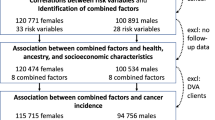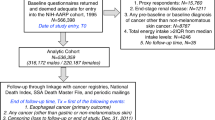Abstract
Background
We quantified the individual and joint contribution of contemporaneous causal behavioural exposures on the future burden of oesophageal and stomach cancers and their subtypes and assessed whether these burdens differ between population groups in Australia, as such estimates are currently lacking.
Methods
We combined hazard ratios from seven pooled Australian cohorts (N = 367,058) linked to national cancer and death registries with exposure prevalence from the 2017–2018 National Health Survey to estimate Population Attributable Fractions (PAFs) with 95% confidence intervals (CIs), accounting for competing risk of death.
Results
Current and past smoking explain 35.2% (95% CI = 11.7–52.4%), current alcohol consumption exceeding three drinks/day 15.7% (95% CI = 0.9–28.4%), and these exposures jointly 41.4% (95% CI = 19.8–57.3%) of oesophageal squamous cell carcinomas in Australia. Current and past smoking contribute 38.2% (95% CI = 9.4–57.9%), obesity 27.0% (95% CI = 0.6–46.4%), and these exposures jointly 54.4% (95% CI = 25.3–72.1%) of oesophageal adenocarcinomas. Overweight and obesity explain 36.1% (95% CI = 9.1–55.1%), current and past smoking 24.2% (95% CI = 4.2–40.0%), and these exposures jointly 51.2% (95% CI = 26.3–67.8%) of stomach cardia cancers. Several population groups had a significantly higher smoking-attributable oesophageal cancer burden, including men and those consuming excessive alcohol.
Conclusions
Smoking is the leading preventable behavioural cause of oesophageal cancers and overweight/obesity of stomach cancers.
This is a preview of subscription content, access via your institution
Access options
Subscribe to this journal
Receive 24 print issues and online access
$259.00 per year
only $10.79 per issue
Buy this article
- Purchase on Springer Link
- Instant access to full article PDF
Prices may be subject to local taxes which are calculated during checkout
Similar content being viewed by others
Data availability
The data that support the findings of this study are available from the corresponding author upon reasonable request.
References
Australian Institute of Health and Welfare. Cancer in Australia 2021. Cancer series no. 133. Cat. no. CAN 144. 2021. https://www.aihw.gov.au/getmedia/0ea708eb-dd6e-4499-9080-1cc7b5990e64/aihw-can-144.pdf.aspx?inline=true. Accessed 7 Apr 2022.
World Cancer Research Fund/American Institute for Cancer Research. Continuous Update Project Expert Report. Diet, nutrition, physical activity and stomach cancer. 2018. dietandcancerreport.org. Accessed 7 Apr 2022.
World Cancer Research Fund/American Institute for Cancer Research. Continuous Update Project Expert Report. Diet, nutrition, physical activity and oeshophageal cancer. 2018. dietandcancerreport.org. Accessed 7 Apr 2022.
International Agency for Research on Cancer. IARC monographs on the evaluation of carcinogenic risks to humans, volume 100E. A review of human carcinogens: Personal habits and indoor combustions. Lyon: IARC; 2012.
Lauby‑Secretan B, Scoccianti C, Loomis D, Grosse Y, Bianchini F, Straif K. Body fatness and cancer—viewpoint of the IARC Working Group. N Engl J Med. 2016;375:794–8.
Arriaga ME, Vajdic CM, Canfell K, MacInnis R, Hull P, Magliano DJ, et al. The burden of cancer attributable to modifiable risk factors: the Australian cancer-PAF cohort consortium. BMJ Open. 2017;7:e016178.
Laaksonen MA, Härkänen T, Knekt P, Virtala E, Oja H. Estimation of population attributable fraction (PAF) for disease occurrence in a cohort study design. Stat Med. 2010;29:860–74.
Australian Bureau of Statistics. National Health Survey: First results 2017-18. Cat. no. 4364.0.55.001. 2018. https://www.abs.gov.au/statistics/health/health-conditions-and-risks/national-health-survey-first-results/latest-release. Accessed 7 Apr 2022, and via ABS DataLab.
Jaro MA. Probabilistic linkage of large public health data files. Stat Med. 1995;14:491–8.
Bray, F, Colombet, M, Piñeros, M, Znaor, A, Zanetti, R, Ferlay, J (eds). Cancer incidence in five continents, Vol. XI. IARC Scientific Publication No. 166. Lyon: IARC; 2021.
Laaksonen MA, Virtala E, Knekt P, Oja H, Härkänen T. SAS macros for calculation of population attributable fraction in a cohort study design. J Stat Softw. 2011;43:1–25.
Australian Institute of Health and Welfare. Cancer incidence projections: Australia, 2011 to 2020. Cancer Series no. 66. Cat. No. CAN 62. 2012. https://www.aihw.gov.au/getmedia/a79de4a1-49f5-4c93-bc59-4d181430aa69/14096.pdf.aspx?inline=true. Accessed 7 Apr 2022.
Poirier AE, Ruan Y, Grevers X, Walter SD, Villeneuve PJ, Friedenreich CM, et al. Estimates of the current and future burden of cancer attributable to active and passive tobacco smoking in Canada. Prev Med. 2019;122:9–19.
Rezende LFM, Murata E, Giannichi B, Tomita LY, Wagner GA, Sanchez ZM, et al. Cancer cases and deaths attributable to lifestyle risk factors in Chile. BMC Cancer. 2020;20:693.
Whiteman DC, Webb PM, Green AC, Neale RE, Fritschi L, Bain CJ, et al. Cancers in Australia in 2010 attributable to modifiable factors: summary and conclusions. Aust N Z J Public Health. 2015;39:477–84.
Wang SM, Katki HA, Graubard BI, Kahle LL, Chaturvedi A, Matthews CE, et al. Population attributable risks of subtypes of esophageal and gastric cancers in the United States. Am J Gastroenterol. 2021;116:1844–52.
Pandeya N, Wilson LF, Webb PM, Neale RE, Bain CJ, Whiteman DC. Cancers in Australia in 2010 attributable to the consumption of alcohol. Aust N Z J Public Health. 2015;39:408–13.
Kendall BJ, Wilson LF, Olsen CM, Webb PM, Neale RE, Bain CJ, et al. Cancers in Australia in 2010 attributable to overweight and obesity. Aust N Z J Public Health. 2015;39:452–7.
Jayasekara H, MacInnis RJ, Lujan-Barroso L, Mayen-Chacon AL, Cross AJ, Wallner B, et al. Lifetime alcohol intake, drinking patterns over time and risk of stomach cancer: a pooled analysis of data from two prospective cohort studies. Int J Cancer. 2021;148:2759–73.
Poirier AE, Ruan Y, Volesky KD, King WD, O’Sullivan DE, Gogna P, et al. The current and future burden of cancer attributable to modifiable risk factors in Canada: summary of results. Prev Med. 2019;122:140–7.
International Agency for Research on Cancer. Radiation. IARC monographs on the evaluation of carcinogenic risks to humans, volume 100D. Lyon: IARC; 2012.
International Agency for Research on Cancer. IARC monographs on the evaluation of carcinogenic risks to humans, volume 100C. A review of human carcinogens: arsenic, metals, fibers, and dusts. Lyon: IARC; 2012.
International Agency for Research on Cancer. IARC monographs on the evaluation of carcinogenic risks to humans, volume 87. Inorganic and organic lead compounds. Lyon: IARC; 2006.
International Agency for Research on Cancer. IARC monographs on the evaluation of carcinogenic risks to humans, volume 70. Epstein-Barr virus and Kaposi’s sarcoma herpesvirus/human herpesvirus 8. Lyon: IARC; 1997.
Antonsson A, Wilson LF, Kendall BJ, Bain CJ, Whiteman DC, Neale RE. Cancers in Australia in 2010 attributable to infectious agents. Aust N Z J Public Health. 2015;39:446–51.
Praud D, Rota M, Pelucchi C, Bertuccio P, Rosso T, Galeone C, et al. Cigarette smoking and gastric cancer in the Stomach Cancer Pooling (StoP) Project. Eur J Cancer Prev. 2018;27:124–33.
Eugene CL. Radiation risk from medical imaging. Mayo Clin Proc. 2010;85:1142–6.
Hammond EC, Selikoff IJ, Seidman H. Asbestos exposure, cigarette smoking and death rates. Ann N Y Acad Sci. 1979;330:473–90.
Offermans NSM, Vermeulen R, Burdorf L, Goldbohm RA, Keszei AP, Peters S, et al. Occupational asbestos exposure and risk of esophageal, gastric and colorectal cancer in the prospective Netherlands Cohort Study. Int J Cancer. 2014;135:1970–7.
Wannamethee SG, Shaper AG, Whincup PH, Walker M. Role of risk factors for major coronary heart disease events with increasing length of follow up. Heart. 1999;81:374–9.
Andersen LB. Relative risk of mortality in the physically inactive is underestimated because of real changes in exposure level during follow-up. Am J Epidemiol. 2004;160:189–95.
Steenland K, Armstrong B. An overview of methods for calculating the burden of disease due to specific risk factors. Epidemiology. 2006;17:512–9.
Samuelsen SO, Eide GE. Attributable fractions with survival data. Stat Med. 2008;27:1447–67.
GBD 2017 Risk Factors Collaborators. Global, regional, and national comparative risk assessment of 84 behavioural, environmental and occupational, and metabolic risks or clusters of risks in 195 countries 1990-2017: a systematic analysis for the Global Burden of Disease Study 2017. Lancet. 2018;392:1923–94.
Acknowledgements
We thank the participating cohort studies and surveys and their participants for the data for this cohort consortium. The 45 and Up Study is managed by the Sax Institute in collaboration with major partner Cancer Council NSW; and partners: the Heart Foundation; NSW Ministry of Health; NSW Department of Communities and Justice; and Australian Red Cross Lifeblood. Specific details of funding and data sources for the Australian Longitudinal Study on Women’s Health are available at: www.alswh.org.au. Cohort recruitment for the Melbourne Collaborative Cohort Study (MCCS) was funded by Cancer Council Victoria (http://www.cancervic.org.au/) and VicHealth (https://www.vichealth.vic.gov.au/). The MCCS was further supported by Australian National Health and Medical Research Council grants 209057 and 396414 and by infrastructure provided by Cancer Council Victoria. The MCCS was made possible by the contribution of many people, including the original investigators, the teams that recruited the participants and continue working on follow-up, and the many thousands of Melbourne residents who continue to participate in the study. The CHAMP study is funded by the NHMRC (ID301916) and the Ageing and Alzheimer’s Institute. We acknowledge the assistance of the AIHW Data Linkage Unit for undertaking the data linkage to the Australian Cancer Database and the National Death Index, and the AIHW Cancer Data and Monitoring Unit for providing the cancer incidence projections. The linked data were managed and accessed through the Sax Institute’s Secure Unified Research Environment (SURE). We also thank the Australian Bureau of Statistics (ABS) for providing access to the National Health Survey data via the ABS DataLab and the ABS staff for their assistance with the analysis.
Funding
This work was supported by the National Health and Medical Research Council of Australia (ID1060991). The National Health and Medical Research Council of Australia also supported MAL (ID1053642), KC (ID1082989), EB (ID1136128), JES (ID1079438) and DJM (ID1118161). MAL was additionally supported by the Cancer Institute New South Wales (ID13/ECF/1-07, 2019/CDF1022).
Author information
Authors and Affiliations
Consortia
Contributions
MAL, SL, and CMV designed the study, conducted the literature review, interpreted the results, and drafted and revised the manuscript. MAL harmonised and analysed the data. KC, RJM, GGG, EB, JEB, DJM, JES, TKG, VH, RGC, PM, and MB contributed substantially to interpreting the results, drafting the manuscript or revising it critically for important intellectual content. All authors approved the final version and agreed to be accountable for all aspects of the work.
Corresponding author
Ethics declarations
Competing interests
KC is co-PI of an investigator-initiated trial of cervical screening, Compass, run by the Australian Centre for Prevention of Cervical Cancer (ACPCC), which is a government-funded not-for-profit charity; the ACPCC has received equipment and funding contribution from Roche Molecular Diagnostics. She is also co-PI on a major investigator-initiated implementation programme Elimination of Cervical Cancer in the Western Pacific (ECCWP) which will receive support from the Minderoo Foundation, the Frazer Family Foundation and equipment donations from Cepheid Inc. Neither KC nor her institution on her behalf receives direct funding from industry for any project. The other authors have no competing interests to declare.
Ethics approval and consent to participate
The Australian Institute of Health and Welfare (AIHW) Ethics Committee approved the study (EC2013/4/62). This study is a data linkage study where data linkage was carried out by external authorities and all data was de-identified. All the participating cohort studies have relevant ethics approvals from human research ethics committees and have obtained informed consent for participation, collection and use of data for health research from each individual. The study was performed in accordance with the Declaration of Helsinki.
Consent for publication
Not applicable.
Additional information
Publisher’s note Springer Nature remains neutral with regard to jurisdictional claims in published maps and institutional affiliations.
Supplementary information
Rights and permissions
Springer Nature or its licensor (e.g. a society or other partner) holds exclusive rights to this article under a publishing agreement with the author(s) or other rightsholder(s); author self-archiving of the accepted manuscript version of this article is solely governed by the terms of such publishing agreement and applicable law.
About this article
Cite this article
Laaksonen, M.A., Li, S., Canfell, K. et al. The future burden of oesophageal and stomach cancers attributable to modifiable behaviours in Australia: a pooled cohort study. Br J Cancer 128, 1052–1069 (2023). https://doi.org/10.1038/s41416-022-02104-x
Received:
Revised:
Accepted:
Published:
Issue Date:
DOI: https://doi.org/10.1038/s41416-022-02104-x



